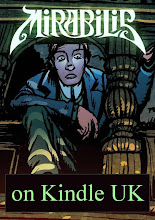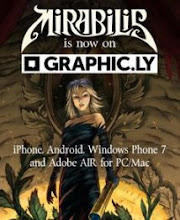Still on writing tips today, but this time specifically how to tell a story with just pictures. The starting point, surprise surprise, is no different from prose: you need to make an emotional connection with the reader. In novels we have voice as the primary and most powerful tool for this. British publisher David Fickling, creator of The DFC in which Mirabilis first appeared as well as the upcoming Phoenix comic, talks about a warmth that is to be found, in various guises, in the voice of all great kids' writers.
Not just kids' writers, in fact. Even when a writer like Graham Greene tells a story of corruption and genocide, or Nabokov invites us to share the viewpoint of a paedophile, what comes across in the narrative voice above all is humanity. Contrast that with supermarket crime novels, where brutal events are described with no trace of human feeling, like a sales rep describing the Holocaust. If the emotional connection between writer and reader is missing, the novel loses its grip. It becomes a mere Powerpoint presentation of plot. The author's voice is what encourages us to strip off the armour of disbelief, expose ourselves to the dangers of the journey, and come away changed by the experience.
In movies, the writer doesn't have that option. You can have tone (often emphasized by a narrator's voiceover) which quickly serves to assure us that Kiss Kiss Bang Bang, say, is not going to be The Salton Sea. Compare the original Blade Runner with the Director's Cut; simply by removing Deckard's voiceover, the tone is altered completely. But tone in a movie is not the same as voice in prose, and in the gap between the two you'll find the reason why movies must have their heroes saving cats and taking care to hit all the beats of the monomyth.
Comics, of course, are not a purely visual medium. The writer is typically more present in the finished work than any director in his movie. Look at Sandman or Swamp Thing. Those are literary works that strongly give the sense that Gaiman and Moore are storytellers speaking directly into our ear. Still more so in the Marvel comics of the Silver Age, where Stan Lee's voice ushered his readers through stories like the patter of a circus ringmaster.
That's not the only way to tell a story in comics, of course. I use no captions in Mirabilis except for Jack's inner thoughts, and those sparingly. I almost never use thought bubbles (unless projected by telepathic brains in jars) because I want the reader to come to these characters as in life or in a long-running TV show: befriending them over time. Still, the author's touch is not and should never be invisible; Hitchcock observes murders in a very different way from Carol Reed. Compare the first ten minutes of The Lady Vanishes and Night Train to Munich. Both were scripted by Launder & Gilliat, both feature Charters and Caldicott as key supporting characters, yet only the former has the warmth that David Fickling spoke of.
Stories are made up of scenes, and the same rules apply at every level. So let's look at an example of how to establish emotional connection using a series of images. This is cinema in its purest form: a sequence of uninflected images that acquire meaning through juxtaposition. And ironically, that pure visual storytelling is best seen these days in commercials. They're selling a product, sure, but they still need to make that direct emotional circuit into the audience's brains. It's all about story.
Take a look at the Virgin Atlantic commercial above. This has a group of Virgin's female cabin crew walking through the terminal attracting gawping looks from men. We see a guy dripping hot dog sauce on his shirt; another forgets all about his videogame. But notice that the commercial doesn’t open on a shot of the stewardesses. Instead, we see a man arriving at the airport. He gets out of the taxi talking on a mobile phone. He looks up, gradually loses interest in the call. The phone slips from his fingers. He sees something that's grabbed his attention, but what? Cut to a reverse shot, past his legs, as the phone breaks on the floor and we get glimpses of the stewardesses walking into shot – and only after that do we get a clear view of them walking towards us, a riot of colour and glamour amid the drab greys of the 1980s.
The commercial is constructed to use both suspense ("What is the man reacting to?") and empathy/identification ("See him? That's how you are meant to feel."). Starting on the stewardesses themselves would give us something to react to, but no viewpoint character to bring us within the story. Of course, we only specifically identify with the man on the phone for a few seconds, then we’re on to a series of loose identifications that gradually diffuse our point of view into the crowd. But in order to place us there as an onlooker in the crowd, the commercial starts off with a perfect little mini-story, complete with lead character, in order to corral our emotional response.
I feel I almost ought to apologize for using a commercial with such an egregious instance of the Male Gaze. There is undeniably a tone in this work, and it is nearer to the sales rep than to Graham Greene. But we can assume that it's male airline passengers whom the ad agency were targeting (apart from the little girl who sadly aspires only to be a honey in a tight red skirt) and, as an example of the visual storytelling craft, this shows perfect construction. But me, I still prefer Air Canada.























No comments:
Post a Comment